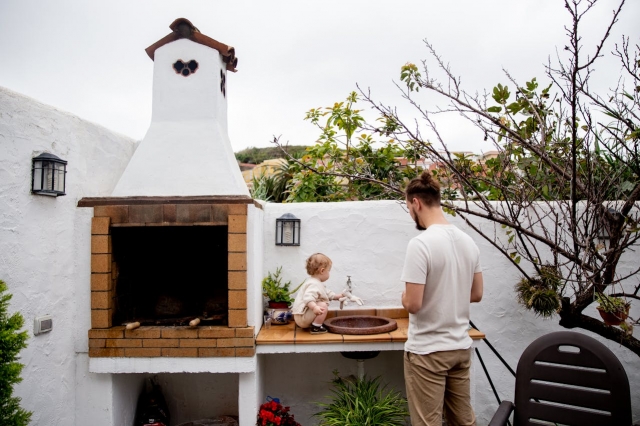Outdoor kitchens allow homeowners to extend their living spaces. They offer dynamic cooking, dining, and socializing venues, making the most of the living experience.
Building an outdoor kitchen focuses on creating a functional space with visual appeal. It's an opportunity to personalize a cooking area that creates a unique ambiance different from the indoor kitchen.
This guide will outline everything you should know about building your outdoor kitchen. From planning to construction, we will provide the essentials to help you create an outdoor kitchen that balances functionality, aesthetics, and sustainability.
Things To Remember When Planning
Planning is crucial in every home transformation. Before buying the materials and setting up your backyard, take note of the following factors when planning your outdoor kitchen project:
Define your cooking style
Will you do everything outside, or do you prefer to prepare indoors and cook and serve outside? Whatever it is, defining your cooking style helps you determine the kind of outdoor kitchen suitable to your needs.
If you prepare the ingredients in the outdoor kitchen, you'll likely need to dedicate space and budget for a counter and a sink.
Moreover, you must consider the maximum number of people you'll be cooking for. It's best to plan the daily meals so you can handle the prep and cooking while accommodating your loved ones or guests.
Check the available space
If you have ample space, the challenge is ensuring your walk from inside to outside is brief.
However, most properties have limited outdoor areas, offering fewer location options for outdoor kitchens. Still, small outdoor kitchens can provide plenty of places for countertops, appliances, and plumbing.
As such, measuring the available space helps determine which appliances to prioritize. It also ensures you have room for every must-have item.
Once you know the area you're working for, you can choose the most suitable outdoor kitchen type to build.
Choose an outdoor kitchen type based on your needs
Here are the types of outdoor kitchens you can construct:
Patio kitchen
Basic patio kitchens typically feature sinks, grills, and under-counter refrigerators. These three components are what most homeowners start with.
Patio kitchens are also space-savers, making them ideal for small outdoor areas.
Barbecue grill island
Another simple outdoor kitchen is a barbecue grill island. This type can be a standalone cooking and grilling area or a larger one with a countertop for food preparations.
U-shape kitchen
A U-shape design lets you maximize the space without cutting the kitchen from the rest of the outdoor area. This type can provide more space for counters, grills, refrigerators, dishwashers, and ovens.
You can place it at the edge of the entertainment area while the open space faces toward where people gather so it feels connected and accessible.
Island kitchen
You can add an island if your patio has an extra space. This feature can add a counter space or seating area. For example, guests can hang out on the island while you prepare and cook. It's also a good option if you don't have space for a dining area.
Consider your location's climate and environment
If you live in an area with a warm climate, you can spend more time in your outdoor kitchen. You can build a large setup as long as you have ample space.
Conversely, for areas that experience extreme weather conditions, your outdoor kitchen's location is crucial. It's best to avoid spots that are too hot, cold, or windy. Patio roofs and appliance covers are also necessary if you live in an area with heavy rainfall.
Check your local codes and regulations
Major gas, electrical, and plumbing work in outdoor kitchens usually require permits. Any structure that covers the kitchen may also be subject to one if it meets specific conditions—like if it's anchored to the home.
Before digging, contact your local permitting department about building codes and related permits. Technicians will check your property to mark gas, electrical, plumbing, and other essential lines. These marks will help you avoid damaging underground utility lines.
Carefully select the materials
When selecting materials for your outdoor kitchen, you must pick durable and weatherproof ones for countertops and cabinets. For example, concrete, brick, stone, and stainless steel are famous for their weather resistance while maintaining appearance and functionality over time.
This careful selection helps ensure your outdoor kitchen's longevity and sustainability. At the same time, it's best to choose materials that complement your interior, exterior, and landscape designs to create a seamless transition between your indoor and outdoor living spaces.
Set realistic goals
Setting unrealistic goals can be tempting when planning your outdoor kitchen. However, being realistic is essential to ensure everything aligns with your needs.
Some considerations you must remember when setting goals include:
- How many people will cook?
- How many people will eat?
- Will you accommodate significant numbers of guests occasionally?
- How often will you use the outdoor kitchen?
You can focus on the most necessary items by answering these questions. Then, gradually add appliances and extras after establishing the kitchen over time.
Create a budget
Once everything is set, outline your budget. Include the materials, appliances, and labor costs.
You should also include additional costs for exterior design services, permits, and professional help for gas, electrical, and plumbing lines.
Before starting the project, ask for quotes from shops and local technicians. This way, you understand the expected costs of building your outdoor kitchen and make better budgeting decisions.

When To Build Your Outdoor Kitchen
When you have a concrete plan and don't have to wait for building materials, you can set a one or three-week hands-on labor to build your outdoor kitchen. You may need more to build a deck or prepare a patio slab.
For these reasons, it's best to set the construction on days when the weather is expected to be mild and dry to avoid rain, snow, and intense heat.
Moreover, installing underground gas, electrical, and plumbing lines is best during mid to late fall. But if you prefer the spring, wait for the soil to thaw and finish the work before summer arrives.
Other considerations when setting the construction date:
- Your and your loved ones' schedules (if you'll ask some relatives or friends who are skilled DIYers)
- Technicians, laborers, and professional electricians and plumbers that require advanced bookings
Steps for Building Your Outdoor Kitchen
If you plan to DIY your outdoor kitchen, keep the following steps in mind:
Prepare the base
Your outdoor kitchen must have a dry, level, and stable base. If you have an existing patio or a sturdy deck, this might be the best place to build the kitchen. But if you don't, you should create one, or at least a flat and firm space that suits the weight of your desired outdoor kitchen.
Some options include:
- Ground-level or floating deck
- Basic patio made of concrete, stones, brick pavers, pea gravel, or masonry
Install the utility lines
- You may need to run gas and electrical lines underground below the frost line, up to four feet below the soil surface.
- You must run electrical lines through conduit or underground with a direct-burial cable. Follow the correct depth specific to your area.
- Install a drain line from the outdoor kitchen to your house's main drain line to meet the plumbing code.
- Unless you're an experienced DIYer or allowed under the local codes, hire an electrician to run the power line.
- Hiring a plumbing contractor to install water, drainage, and gas supply pipes is ideal.
Establish the shelter structure
It's best to use an overhead shelter in warm climates with direct sun for the shelter structure. In contrast, full enclosures with insect screens are best for northern climates.
Your shelter structure can be as simple as a fabric sailcloth or a fully enclosed gazebo. Another option is building a pergola, which you can cover with open latticework or a retractable canopy.
If you plan to convert your shed, a personalized shed kit design can help you build an outdoor kitchen within the structure. Professional building kit providers like Worldwide Steel Buildings offer hands-on guidance for such projects, ensuring your shed's shelter structure meets your outdoor kitchen needs.
Install the cabinets and countertops
When laying out the base cabinets, you should leave spaces for a refrigerator and a grill if you're including them. It's also possible to mount wall cabinets on your home's exterior to create more storage.
Using natural or veneer stone, pallet wood, or stainless steel for your cabinets is best.
Moreover, you can make countertops versatile by dedicating spaces for preparation, kitchenware, and grilling supplies. Stainless steel, natural or synthetic stones like quartz, and other solid surface materials are best for these components. Or, you could DIY concrete countertops by pouring concrete into molds.
Finish the utility work and install appliances
After finishing the utility work, contact your local building inspector for final inspections and permit closing. In some locals, these inspections are done by two inspectors—one for plumbing and gas, one for wiring.
Once the inspections are done, you can now install the appliances.
Decorate your outdoor kitchen
Now that everything is finished, add tables, chairs, and decorations. Examples include:
- Moveable patio table
- Picnic table
- Tables with built-in seating areas
- Firepits
- Floor covers
- An herb garden
- Decorative lights
Seek professional help
Even the most experienced DIYers will call professionals for significant construction jobs. It's best to seek professional help if your DIY experience is limited or the local codes have limitations.
Professional technicians, plumbers, and carpenters help ensure your outdoor kitchen is in optimal condition and complies with the law.
Bring Your Dream Outdoor Kitchen to Life
Your outdoor kitchen project is an opportunity to create a space that enriches your lifestyle.
With strategic planning, you can build an outdoor kitchen that mirrors your style and meets your practical needs, ultimately providing a versatile and welcoming environment for cooking, socializing, and relaxation.






